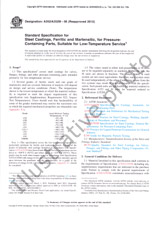We need your consent to use the individual data so that you can see information about your interests, among other things. Click "OK" to give your consent.
ASTM D8205-20
Standard Guide for Video Surveillance System
Translate name
STANDARD published on 1.2.2020
The information about the standard:
Designation standards: ASTM D8205-20
Publication date standards: 1.2.2020
SKU: NS-985173
The number of pages: 3
Approximate weight : 9 g (0.02 lbs)
Country: American technical standard
Category: Technical standards ASTM
Annotation of standard text ASTM D8205-20 :
Keywords:
authority having jurisdiction (AHJ), auxiliary power, coverage, credential, currency, digital video recorder (DVR), maintenance, monitoring, notification, procedures, recording, resin cannabis, storage, testing, two-factor authentication, uninterruptible power supply (UPS), video management software (VMS),
Additional information
| Significance and Use |
|
3.1 The video surveillance system safeguards various areas considered critical to operations. The surveillance system uses cameras capable of capturing images and videos that can be compressed, stored, or sent over communication networks. The main difference between a digital video surveillance system and an analog video surveillance system is that a digital video surveillance system is capable of capturing and storing the video signal in a digital format. A digital video surveillance solution can be managed from anywhere and provide interoperability. The cameras can be networked and footage encrypted and digitally archived, which is considered crucial for most resin cannabis businesses because the video feed can be secured and shared with government authorities. |
| 1. Scope |
|
1.1 This guide covers the recommended video surveillance system for protecting resin cannabis, resin cannabis products, resin cannabis waste, currency, people, property, and assets. 1.2 Units—The values stated in inch-pound units are to be regarded as the standard. The values given in parentheses are mathematical conversions to SI units that are provided for information only and are not considered standard. 1.3 This standard does not purport to address all of the safety concerns, if any, associated with its use. It is the responsibility of the user of this standard to establish appropriate safety, health, and environmental practices and determine the applicability of regulatory limitations as defined by the Authority Having Jurisdiction (AHJ) prior to use. 1.4 This international standard was developed in accordance with internationally recognized principles on standardization established in the Decision on Principles for the Development of International Standards, Guides and Recommendations issued by the World Trade Organization Technical Barriers to Trade (TBT) Committee. |
We recommend:
Technical standards updating
Do you want to make sure you use only the valid technical standards?
We can offer you a solution which will provide you a monthly overview concerning the updating of standards which you use.
Would you like to know more? Look at this page.




 Cookies
Cookies
